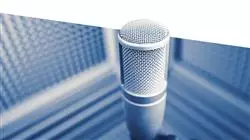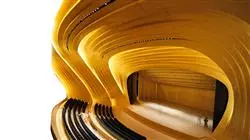University certificate
The world's largest faculty of engineering”
Introduction to the Program
You will master the recording and post-production process, as well as the most innovative technologies associated with Audio Engineering"

The music industry generates, despite new ways of socializing its products, millions of dollars in profits every year. However, consumers are increasingly demanding and seek out sound materials with the highest audio quality and creative experimentation. To be able to implement the latest advances in the industry and make pieces of greater excellence, sound engineers must be highly prepared and fully handle the most advanced techniques and instruments. For this reason, TECH Global University has gathered the most cutting-edge resources and working methods in this field in a program of studies with 3 intensive modules and 6 months of duration.
This Postgraduate diploma in Audio Engineering examines the most innovative calibration systems that can be applied to analyze noise, vibrations and other aspects of sound. It also addresses pressure, acoustic intensity, excitation sources, impedance and several other parameters. Furthermore, the syllabus focuses on microphones, providing exhaustive criteria on the choice and positioning of these instruments to capture sound information in the most appropriate way.
The curriculum of the program will allow each member of the student body to delve into the theoretical and practical bases of sound mixing techniques, audio editing, multichannel mixing and signal processing. Therefore, graduates will be able to play an essential role in the recording and production of music bands, podcasts, among others.
All these study contents have been chosen in detail by a teaching staff with extensive professional experience and prestige. In addition to the materials, these experts have provided complementary readings, explanatory videos and interactivesummaries. The mastery of the advanced aspects of this syllabus will be developed in a ast, intensive and flexible way thanks to its 100% online methodology. The latter is based on the exclusive Relearning teaching system that allows the continuous reiteration of the most complex concepts.
Make your way in the professional sphere of the acoustic industry with the updated contents of this Postgraduate diploma"
This Postgraduate diploma in Audio Engineering contains the most complete and up-to-date program on the market. The most important features include:
- Development of case studies presented by experts in Acoustics engineering
- The graphic, schematic and practical contents of the program provide technical and practical information on those disciplines that are essential for professional practice
- The practical exercises where the self-evaluation process can be carried out to improve learning
- Its special emphasis on innovative methodologies
- Theoretical lessons, questions to the expert, debate forums on controversial topics, and individual reflection assignments
- Content that is accessible from any fixed or portable device with an Internet connection
Looking for a program that fits your schedule and obligations? TECH provides you with academic rigor in an exclusive online format"
The program includes in its teaching staff professionals of the field who pour into this training the experience of their work, in addition to recognized specialists from reference societies and prestigious universities.
Its multimedia content, developed with the latest educational technology, will allow the professional a situated and contextual learning, that is, a simulated environment that will provide an immersive training programmed to train in real situations.
The design of this program focuses on Problem Based Learning, through which the professional must try to solve the different professional practice situations that arise during the academic year. For this purpose, the student will be assisted by an innovative interactive video system created by renowned experts.
The multimedia resources of this program include explanatory videos, interactive summaries and other complementary materials"

Don't miss the opportunity to update your skills from anywhere in the world, with the portable device of your choice"
Why study at TECH?
TECH is the world’s largest online university. With an impressive catalog of more than 14,000 university programs available in 11 languages, it is positioned as a leader in employability, with a 99% job placement rate. In addition, it relies on an enormous faculty of more than 6,000 professors of the highest international renown.

Study at the world's largest online university and guarantee your professional success. The future starts at TECH”
The world’s best online university according to FORBES
The prestigious Forbes magazine, specialized in business and finance, has highlighted TECH as “the world's best online university” This is what they have recently stated in an article in their digital edition in which they echo the success story of this institution, “thanks to the academic offer it provides, the selection of its teaching staff, and an innovative learning method aimed at educating the professionals of the future”
A revolutionary study method, a cutting-edge faculty and a practical focus: the key to TECH's success.
The most complete study plans on the university scene
TECH offers the most complete study plans on the university scene, with syllabuses that cover fundamental concepts and, at the same time, the main scientific advances in their specific scientific areas. In addition, these programs are continuously being updated to guarantee students the academic vanguard and the most in-demand professional skills. In this way, the university's qualifications provide its graduates with a significant advantage to propel their careers to success.
TECH offers the most comprehensive and intensive study plans on the current university scene.
A world-class teaching staff
TECH's teaching staff is made up of more than 6,000 professors with the highest international recognition. Professors, researchers and top executives of multinational companies, including Isaiah Covington, performance coach of the Boston Celtics; Magda Romanska, principal investigator at Harvard MetaLAB; Ignacio Wistumba, chairman of the department of translational molecular pathology at MD Anderson Cancer Center; and D.W. Pine, creative director of TIME magazine, among others.
Internationally renowned experts, specialized in different branches of Health, Technology, Communication and Business, form part of the TECH faculty.
A unique learning method
TECH is the first university to use Relearning in all its programs. It is the best online learning methodology, accredited with international teaching quality certifications, provided by prestigious educational agencies. In addition, this disruptive educational model is complemented with the “Case Method”, thereby setting up a unique online teaching strategy. Innovative teaching resources are also implemented, including detailed videos, infographics and interactive summaries.
TECH combines Relearning and the Case Method in all its university programs to guarantee excellent theoretical and practical learning, studying whenever and wherever you want.
The world's largest online university
TECH is the world’s largest online university. We are the largest educational institution, with the best and widest online educational catalog, one hundred percent online and covering the vast majority of areas of knowledge. We offer a large selection of our own degrees and accredited online undergraduate and postgraduate degrees. In total, more than 14,000 university degrees, in eleven different languages, make us the largest educational largest in the world.
TECH has the world's most extensive catalog of academic and official programs, available in more than 11 languages.
Google Premier Partner
The American technology giant has awarded TECH the Google Google Premier Partner badge. This award, which is only available to 3% of the world's companies, highlights the efficient, flexible and tailored experience that this university provides to students. The recognition as a Google Premier Partner not only accredits the maximum rigor, performance and investment in TECH's digital infrastructures, but also places this university as one of the world's leading technology companies.
Google has positioned TECH in the top 3% of the world's most important technology companies by awarding it its Google Premier Partner badge.
The official online university of the NBA
TECH is the official online university of the NBA. Thanks to our agreement with the biggest league in basketball, we offer our students exclusive university programs, as well as a wide variety of educational resources focused on the business of the league and other areas of the sports industry. Each program is made up of a uniquely designed syllabus and features exceptional guest hosts: professionals with a distinguished sports background who will offer their expertise on the most relevant topics.
TECH has been selected by the NBA, the world's top basketball league, as its official online university.
The top-rated university by its students
Students have positioned TECH as the world's top-rated university on the main review websites, with a highest rating of 4.9 out of 5, obtained from more than 1,000 reviews. These results consolidate TECH as the benchmark university institution at an international level, reflecting the excellence and positive impact of its educational model.” reflecting the excellence and positive impact of its educational model.”
TECH is the world’s top-rated university by its students.
Leaders in employability
TECH has managed to become the leading university in employability. 99% of its students obtain jobs in the academic field they have studied, within one year of completing any of the university's programs. A similar number achieve immediate career enhancement. All this thanks to a study methodology that bases its effectiveness on the acquisition of practical skills, which are absolutely necessary for professional development.
99% of TECH graduates find a job within a year of completing their studies.
Postgraduate Diploma in Audio Engineering
In the dynamic world of audio engineering, technical excellence and creativity intertwine to shape unforgettable sound experiences. At TECH Global University, we invite you to explore this exciting field through our Audio Engineering Postgraduate Diploma, a program designed to catapult your career to new heights. Taught online, this program gives you the opportunity to immerse yourself in the intricacies of audio engineering from the comfort of your home or any location of your choice. At TECH Global University, we recognize the importance of flexibility in learning, which is why we have created an interactive online environment where you can access the latest knowledge and best practices in the audio industry.
Audio Engineering Course Audio Engineering Course Audio Engineering Course.
Start building your future by being part of the best university
Our program focuses not only on theory, but also on the practical application of concepts. You'll learn to use the latest audio engineering tools and technologies, developing skills that are directly transferable to real-world situations. From music production to sound design for film and video games, you will be equipped to meet any challenge in the field of audio engineering. One of the main advantages of our online mode is the ability to learn at your own pace. You will no longer be limited by geographical barriers or time constraints. With 24-hour access to high-quality materials and guidance from industry experts, you'll have the freedom to customize your educational experience to fit your schedule and needs. By joining our Audio Engineering Postgraduate Diploma program, you'll have access to a global community of passionate audio enthusiasts. Prepare to enter a world of creative and technical possibilities and open doors to exciting career opportunities in the entertainment industry and beyond. Your journey to audio engineering mastery starts here - enroll now and make your talent resonate!







